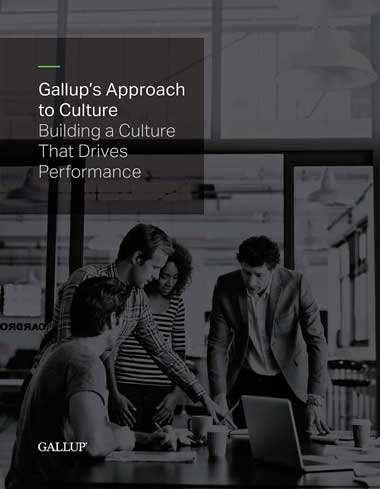Story Highlights
- Most organizations struggle to bring value to life every day for employees
- With teams spread worldwide, practicing culture can be challenging
- Gain techniques to create the ideal cultural foundation needed
Culture is an asset. It defines "how work gets done around here." But culture only creates value when it aligns with your company's values, provides a consistent employee experience, brings the mission and purpose of your organization to life, and delivers on the promises you make to your customers.
"How work gets done" often has an aspirational element, but it still communicates what is most important in your company -- "how we do things" and also, subtly, "how we don't do things." These values are promises that create real expectations about how coworkers, managers and leaders behave, interact and do their jobs.
Your company needs to deliver on those promises by ensuring the cultural experience for all employees is consistent with those expectations. Unfortunately, most organizations struggle to bring their values to life for employees each day.
Only 23% of U.S. employees strongly agree that they can apply their organization's values to their work every day.
Create clear and consistent expectations for all.
Operating in multiple geographic locations magnifies the challenge. When people can't be quickly and frequently gathered, it's difficult to ensure culture is understood and practiced as intended. Nonetheless, leaders are responsible for ensuring the culture of each local organization is consistent with the overall organization's desired identity -- and that local managers and supervisors are aligned with it.
Only 23% of U.S. employees strongly agree that they can apply their organization's values to their work every day.
Here are two techniques leaders can use to create a cultural foundation that delivers an employee experience that is consistent with the organization's global values:
1. Use a variety of communication formats.
First, HQ and field leaders need multiple communication vehicles -- posters, newsletters, podcasts, emails, table tents, slack channels, to name a few -- to explain their desired culture and why it is important to employees. Too often, corporate headquarters' messaging doesn't reach the branches, plants or field offices in a way that workers can use.
As a result, many employees just don't hear an operable cultural message -- but they need that communication just as much, if not more, than corporate population centers.
Conversations led by local leaders in town hall-type meetings, onboarding processes that create memorable and consistent experiences for employees, and other rituals that communicate expectations are critical to ensuring employees' awareness of and alignment with the culture that the organization is seeking to create.
2. Connect the words to the work.
Local leaders and managers must comprehend the overall culture so well that they can apply the existing and aspirational values of that culture to the day-to-day work of employees.
And they should be able to discuss, in words everyone can relate to, what each of the organization's values means to them personally, what each one means relative to the team's work, and what the implications of these values are for employee interactions.
This may play out differently on different teams -- "integrity" might mean one thing to an accounting team, another to a sales team and something else to an IT team. But with a strong culture, all of those teams can bring integrity to life each day in a way that drives business results.
Culture only creates value when it aligns with your company's values, provides a consistent employee experience, brings the mission and purpose of your organization to life, and delivers on the promises you make to your customers.
The capacity to connect cultural messaging to actual work can be built through professional development training, expectation setting from leadership, role modeling, and storytelling from the highest levels of the organization. In any case, it's vital that local leaders and managers are entitled to shape the culture that affects how work gets done on their team. But they'll only do it if they feel ownership for the culture. Creating a sense of ownership can -- and should -- be done in tandem with accountability.
One technique is holding local leaders and managers responsible for specific cultural attributes, policies or processes. For example, if a manager is skilled at building trust with a team, top leaders can make that manager responsible for sharing with other managers best practices for creating trust -- and they should hold that manager accountable for doing so. This not only encourages the sharing of best practices (which is useful) but also creates an accountability mechanism that demonstrates and promotes an organizational value.
Communicate the asset your culture should be.
Organizational culture must transcend geography -- if it doesn't, it's not an organizational culture at all. It's just a collection of customs, surrounded by an imaginary boundary. In such companies, far-flung locations can easily become disconnected from the organization's overall strategies, goals and expectations.
Customers can sense a culture like that. They may not know that a company's culture is geographically fractured, but they can tell when the brand promise is delivered haphazardly.
Employees can feel the effects of a divided culture too, and they know when their brand isn't delivering on its promises: Only 26% of U.S. workers believe their organization always delivers on the promises it makes to customers.
It's vital that local leaders and managers are entitled to shape the culture that affects how work gets done on their team.
Strong cultures are very different. They create a consistent employee experience with consistent values that enable consistent delivery of the brand promise. Remember, to customers, your brand represents one organization, one culture, one promise -- and it's tough to sustain that impression with a splintered culture. Bring geographically divided employees together with constant communication and work connected to corporate values, and you'll make your culture the asset it should be.
Reap the rewards of a lively culture:
- Create a culture that gets the best from your people through Gallup's comprehensive culture solutions.
- Download this report to build a high-development workplace culture driven by engagement.
- Read this article to learn how to ask the right questions to know if your culture is hurting your business.




